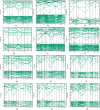Structural, Electronic Properties, and Relative Stability Studies of Low-Energy Indium Oxide Polytypes Using First-Principles Calculations
- PMID: 37065075
- PMCID: PMC10099427
- DOI: 10.1021/acsomega.3c00105
Structural, Electronic Properties, and Relative Stability Studies of Low-Energy Indium Oxide Polytypes Using First-Principles Calculations
Abstract
Materials made of indium oxide (In2O3) are now being used as a potential component of the next generation of computers and communication devices. Density functional theory is used to analyze the physical, electrical, and thermodynamical features of 12 low-energy bulk In2O3 polytypes. The cubic structure In2O3 is majorly used for many of the In2O3-based transparent conducting oxides. The objective of this study is to explore other new stable In2O3 polytypes that may exist. The structural properties and stability studies are performed using the Vienna ab initio simulation package code. All the In2O3 polytypes have semiconductive properties, according to electronic band structure investigations. The full elastic tensors and elastic moduli of all polytypes at 0 K are computed. Poisson's and Pugh's ratio confirms that all stable polytypes are ductile. The phonon and thermal properties including heat capacity are obtained for mechanically stable polytypes. For the first time, we report the Raman and infrared active modes of stable polytypes.
© 2023 The Authors. Published by American Chemical Society.
Conflict of interest statement
The authors declare no competing financial interest.
Figures










Similar articles
-
Investigating Stable Low-Energy Gallium Oxide (Ga2O3) Polytypes: Insights into Electronic and Optical Properties from First Principles.ACS Omega. 2024 Mar 26;9(14):16207-16220. doi: 10.1021/acsomega.3c10192. eCollection 2024 Apr 9. ACS Omega. 2024. PMID: 38617702 Free PMC article.
-
Ab-initio insights into the mechanical, phonon, bonding, electronic, optical and thermal properties of hexagonal W2N3 for prospective applications.Heliyon. 2024 Jun 25;10(13):e33613. doi: 10.1016/j.heliyon.2024.e33613. eCollection 2024 Jul 15. Heliyon. 2024. PMID: 39035499 Free PMC article.
-
Physical properties of Be-Based fluoroperovskite compounds XBeF3(X = K, Rb): a first-principles study.J Phys Condens Matter. 2023 Oct 23. doi: 10.1088/1361-648X/ad05f9. Online ahead of print. J Phys Condens Matter. 2023. PMID: 37871596
-
Structure, energetics, and electronic states of III-V compound polytypes.J Phys Condens Matter. 2013 Jul 10;25(27):273201. doi: 10.1088/0953-8984/25/27/273201. Epub 2013 Jun 19. J Phys Condens Matter. 2013. PMID: 23778868 Review.
-
Recent Advances of Indium Oxide-Based Catalysts for CO2 Hydrogenation to Methanol: Experimental and Theoretical.Materials (Basel). 2023 Mar 31;16(7):2803. doi: 10.3390/ma16072803. Materials (Basel). 2023. PMID: 37049097 Free PMC article. Review.
Cited by
-
Investigations of In2O3 Added SiC Semiconductive Thin Films and Manufacture of a Heterojunction Diode.Nanomaterials (Basel). 2024 May 19;14(10):881. doi: 10.3390/nano14100881. Nanomaterials (Basel). 2024. PMID: 38786836 Free PMC article.
-
Investigating Stable Low-Energy Gallium Oxide (Ga2O3) Polytypes: Insights into Electronic and Optical Properties from First Principles.ACS Omega. 2024 Mar 26;9(14):16207-16220. doi: 10.1021/acsomega.3c10192. eCollection 2024 Apr 9. ACS Omega. 2024. PMID: 38617702 Free PMC article.
References
-
- Khan H.; Bera S.; Sarkar S.; Jana S. Fabrication, structural evaluation, optical and photoelectrochemical properties of soft lithography based 1D/2D surface patterned indium titanium oxide sol-gel thin film. Surf. Coatings Technol. 2017, 328, 410–419. 10.1016/j.surfcoat.2017.09.007. - DOI
-
- Bierwagen O. Indium oxide - A transparent, wide-bandgap semiconductor for (opto)electronic applications. Semicond. Sci. Technol. 2015, 30, 24001.10.1088/0268-1242/30/2/024001. - DOI
-
- Forsh E. A.; Abakumov A. M.; Zaytsev V. B.; Konstantinova E. A.; Forsh P. A.; Rumyantseva M. N.; Gaskov A. M.; Kashkarov P. K. Optical and photoelectrical properties of nanocrystalline indium oxide with small grains. Thin Solid Films 2015, 595, 25–31. 10.1016/j.tsf.2015.10.053. - DOI
-
- Yahia A.; Attaf A.; Saidi H.; Dahnoun M.; Khelifi C.; Bouhdjer A.; Saadi A.; Ezzaouia H. Structural, optical, morphological and electrical properties of indium oxide thin films prepared by sol gel spin coating process. Surf. Interfaces 2019, 14, 158–165. 10.1016/j.surfin.2018.12.012. - DOI
LinkOut - more resources
Full Text Sources

